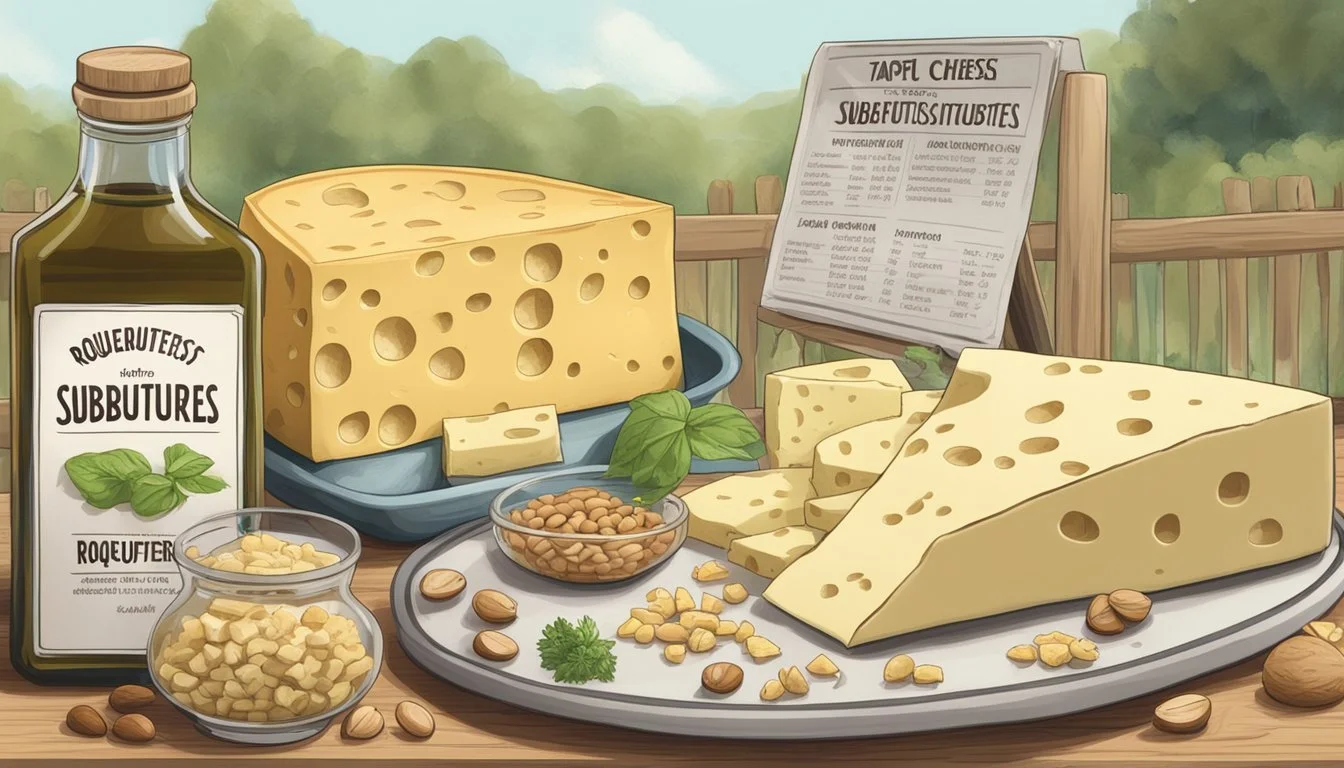Roquefort Cheese Substitutes
Top Alternatives for Your Recipes
Roquefort cheese (What wine goes well with cheese?), with its sharp flavors and rich history, has enjoyed a celebrated status among blue cheese varieties. Originating from the south of France and made from the milk of specially-bred sheep, its distinctive tang and crumbly texture are imparted by the mold Penicillium roqueforti. A true Roquefort is easily recognized by its moist, ivory body laced with greenish-blue veins. However, those with dietary restrictions or a preference for different tastes might seek alternatives that capture the spirit of Roquefort without the exact flavor profile or ingredients.
In the quest for substitutes, a number of other blue cheeses offer similar qualities. Gorgonzola, an Italian cheese made from unskimmed cow's milk, is a popular alternative known for a comparably tangy bite and a slightly softer texture. Stilton, hailing from England, provides another option, with a rich, mellow taste and creaminess that pairs well in recipes calling for Roquefort. For individuals avoiding dairy, plant-based cheeses made from nuts and seasoned with umami flavors to replicate the characteristic pungency of blue cheeses can be excellent non-dairy alternatives. Each substitute offers a different nuance, potentially adding a new dimension to the dishes that traditionally feature Roquefort.
Understanding Roquefort Cheese
Roquefort cheese is a traditional blue cheese from southern France with distinctive blue veins, known for its tangy flavor and crumbly texture. Here we explore its origins, characteristic flavors, textures, and culinary uses.
Origin and Production
Location: Southern France
Key Attribute: Protected Designation of Origin
Roquefort cheese has its roots deeply embedded in the limestone caves of Southern France's Auvergne region. It is made exclusively from the milk of Lacaune sheep. The cheese obtains its protected status from a designation known as Appellation d'Origine Contrôlée (AOC), ensuring that only cheeses from this region can bear the name Roquefort.
Characteristic Flavors
Primary Flavors: Tangy, Sharp, Salty
Aroma: Pungent
Roquefort's flavor profile is nothing short of bold. The tanginess and sharpness of the cheese are well-pronounced, accompanied by a salty taste that tickles the palate. Its pungent aroma is a direct result of the blue mold used during its fermentation process, contributing to its pronounced and complex flavor.
Textural Profile
Consistency: Creamy Center, Crumbly Edges
Veining: Pronounced Blue Veining
The texture of Roquefort cheese can be described as paradoxical; while it has a creamy center, the edges tend to crumble, which is characteristic of many aged cheeses. Its defining feature, the blue veining, not only contributes to the aesthetic but also infuses the cheese with its signature sharpness.
Culinary Uses
Ideal For: Salads, Pasta, Pizza
Experience: Enhances with Complexity
A versatile cheese in the kitchen, Roquefort can be crumbled over salads, melted into pastas, or even added atop pizzas. It is also enjoyed as an after-dinner cheese, providing a powerful finish to a meal. Its creamy and crumbly texture, along with the strong flavor profile, add depth to each dish it is part of.
Cheese Substitutes for Roquefort
When the distinct, sharp flavor of Roquefort cheese is desired but unavailable, a variety of other cheeses can offer comparable tastes and textures.
Similar Blue Cheeses
Gorgonzola: This Italian blue cheese is creamy with a mild, slightly sweet flavor. Gorgonzola Dolce is a softer, milder variety, while regular Gorgonzola is more firm and intense.
Stilton: An English cheese with a rich and mellow flavor, and a slightly crumbly texture.
Danablu (Danish Blue): It has a milder flavor than Roquefort but still offers a good amount of tanginess.
Maytag Blue Cheese: An American cheese that provides a crumbly texture and a spicy kick.
Cabrales: This Spanish cheese is intense and pungent, but works well as a Roquefort stand-in.
Non-Blue Cheese Alternatives
Feta Cheese: While not a blue cheese, feta offers a tangy taste and crumbly texture which can substitute Roquefort in salads and cold dishes.
Cheddar Cheese: Aged cheddar, with its sharp taste, can sometimes be used as a Roquefort substitute in cooked dishes.
Vegan and Dairy-Free Options
Vegan Blue Cheese: These products are typically nut-based, commonly with cashews, and engineered to replicate the creamy texture and unique flavor profile of blue cheeses.
Cottage Cheese or Ricotta: For those seeking a milder flavor and less fat, these can be seasoned to bring a cheese-like flavor to dishes.
Factors to Consider When Choosing a Substitute
In selecting a suitable substitute for Roquefort cheese, one must assess factors such as flavor compatibility, texture, cooking requirements, and the cheese's origin. These considerations ensure that the replacement cheese complements the dish as closely as possible to the original ingredient.
Flavor Profile Comparison
When replacing Roquefort cheese, the substitute should ideally have a tangy, salty, and somewhat sharp flavor. Gorgonzola, an Italian blue cheese, offers a similar tanginess and sharpness, making it a good match. Stilton, a British cheese, provides a comparable tang with a slightly nutty flavor that may also fit well in dishes that originally call for Roquefort.
Texture and Consistency
Roquefort's texture is characteristically creamy and soft, yet can also be crumbly. Substitutes should mimic this as closely as possible. For example, Stilton is firmer but not as crumbly. Gorgonzola is generally creamier, making it a suitable alternative for recipes that benefit from a smoother texture.
Culinary Application
The chosen substitute should function well within the intended culinary application. Roquefort works well in gratins, sandwiches, salads, and various culinary creations, including baking recipes. Gorgonzola melts well, making it appropriate for hot dishes, while Stilton's crumbly nature is excellent for salads and non-heated applications.
Availability and Origins
Roquefort, a French cheese by origin, might not be readily available everywhere. Substitutes like Gorgonzola (Italian cheese) and Stilton (British cheese) might be more accessible in some areas. In the United States, domestic blue cheeses could also serve as replacements, although each will bring its regional taste profile and might be less tangy or salty.
Pairing and Serving Suggestions
When selecting substitutes for Roquefort cheese, one must consider the pairing of these alternatives with appropriate foods and beverages to enhance the culinary experience. The goal is to match the intensity and flavor profiles for a harmonious outcome.
Complementary Foods and Beverages
Fruits: Pears and apples slice harmoniously with Gorgonzola's tanginess.
Nuts: Walnuts add a crunchy texture that complements the creamy nature of Stilton.
Bread: A crusty baguette serves as a neutral carrier for milder blue cheeses like Bleu d'Auvergne.
Wine Pairing: Port wine with its sweetness balances the saltiness of blue cheese substitutes, while a robust red wine can stand up to their strong flavors.
Creating Balanced Cheese Platters
Cheese Platters: Mix milder blue cheese alternatives with creamy and hard cheeses for variety.
Crackers and Bread: Offer a selection, from crispy crackers to hearty bread, ensuring a pleasing texture contrast.
Olives: Introduce an element of brininess with olives.
Charcuterie (What wine goes well with charcuterie?): Add cured meats for savory depth.
Tip: Always consider the intensity of the cheese when selecting accompaniments, aiming for balance and variety on the platter.
Incorporating into Recipes
Pizzas: Gorgonzola makes a piquant topping, especially when paired with figs or caramelized onions.
Salads: Crumbled Stilton adds a bold flavor to salads, especially when combined with nuts and sweet dressings.
Pasta Dishes: Blue cheese alternatives can be melted into sauces, giving pasta a decadently creamy texture.
Note: When using cheese substitutes in recipes, one must be mindful of their melting characteristics to ensure the desired consistency and flavor profile.
Health Considerations
When considering substitutes for Roquefort cheese, it's essential to examine the health implications, particularly the nutritional content and potential allergens. Substitutes can vary significantly in these areas, affecting individuals with dietary restrictions or specific health goals.
Nutritional Content
The nutritional profile of a cheese substitute is a key concern. Roquefort, like many cheeses, is rich in proteins and fats, and substitutes may offer a similar or different nutrient composition. For example, Gorgonzola cheese, a potential substitute, provides a fat and protein content comparable to Roquefort. A substitute's nutritional value should align with an individual's dietary needs and health objectives.
Nutrient Roquefort (per 100g) Gorgonzola (per 100g) Calories 369 356 Fat 32g 28.74g Saturated Fat 19g 18.669g Protein 21g 21.40g Carbohydrates 2g 2.34g
Allergies and Dietary Restrictions
Roquefort and its substitutes may contain mold spores and lactose, which can affect individuals with dairy allergies or lactose intolerance. Those with a allergy to dairy should avoid cheese substitutes derived from cow's milk altogether. For those with lactose intolerance, they should be cautious as cheese can vary in lactose content; aged cheeses like Roquefort generally contain less lactose but still might trigger discomfort. Non-dairy substitutes, such as olives or hummus, provide alternatives free from lactose and dairy proteins.
Final Thoughts on Roquefort Substitutes
When it comes to replacing Roquefort cheese, enthusiasts have several excellent options to consider. Gorgonzola stands out as a top candidate. Originating from Italy, it boasts a similarly tangy and sharp flavor, with a creamy consistency. Gorgonzola's bold presence in dishes makes it a strong alternate for Roquefort.
For those preferring an English touch, Stilton cheese is an admirable choice. It shares the tangy nature of Roquefort but is firmer and less crumbly due to a longer aging process. Stilton's rich history as the "King of English Cheeses" ensures a quality and complexity that can enrich any recipe calling for Roquefort.
Comparative Table of Substitutes:
Substitute Origin Texture Flavor Notes Aging Process Gorgonzola Italy Creamy Tangy, Sharp Moderate Stilton England Firmer, Less Crumbly Piquant Prolonged
For a French alternative, one does not need to look far: Bleu d'Auvergne is a sublime Roquefort substitute. Produced in the same country, it shares many sensory attributes, including a strong, salty flavor coupled with a thin, edible rind that matures well over a few months.
Lastly, for those straying from dairy, vegan options based on nuts, specifically cashews, offer a creaminess that mimics Roquefort. These plant-based alternatives are blended with various flavor enhancers to reproduce the umami and complex profile of traditional blue cheeses.
In choosing a Roquefort substitute, the key lies in identifying which characteristics of Roquefort—be it creaminess, tanginess, or a distinct blue cheese flavor—are most essential to the dish in question and selecting a substitute accordingly.






